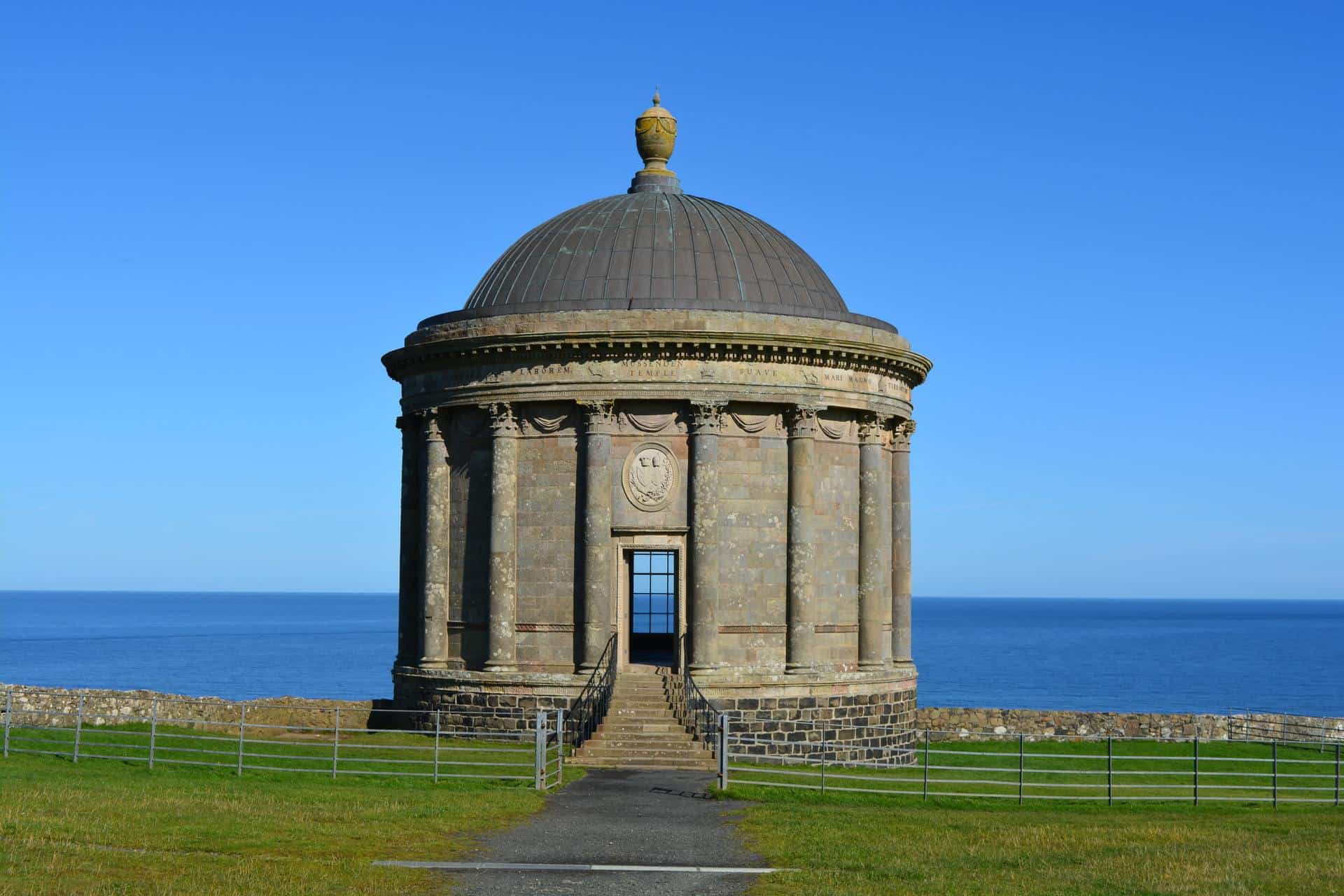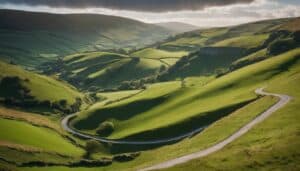Mussenden Temple | Downhill Demesne, Northern Ireland

Updated On: February 25, 2024 by Ahmed Samir
Northern Ireland has a wide array of historical sites and must-visit attractions. Mussenden Temple is the top of them. More importantly, it’s a great haven to escape crowds and enjoy the spectacular view.
Perched atop a rugged cliff on the North Atlantic coast of Northern Ireland, Mussenden Temple is a testament to architectural brilliance and nature’s enduring beauty. This neoclassical folly, located within the Downhill Demesne estate, has captured the hearts of visitors for centuries with its stunning views and rich history. In this article, we will delve into the fascinating story behind Mussenden Temple, exploring its history, design, cultural significance, and the awe-inspiring landscape surrounding it.
Discovering Downhill Demesne: Beyond Mussenden Temple
Downhill Demesne is a historic estate encompassing not only Mussenden Temple but also a wealth of natural beauty, architectural wonders, and cultural heritage. Situated on the rugged Northern Irish coast near Castlerock, this expansive estate offers visitors various attractions and activities.
1. Historic Mansion: At the heart of Downhill Demesne stands the Downhill House, a grand mansion once the residence of Frederick Hervey, the 4th Earl of Bristol. While the house is now in ruins, its imposing façade and the surrounding gardens are an evocative reminder of its former glory. Exploring the remnants of this historic mansion provides a glimpse into the opulent lifestyle of the aristocracy in the 18th century.
2. Gardens and Grounds: The estate’s well-maintained gardens are a horticultural delight. From vibrant rhododendrons to perfectly manicured lawns, the gardens offer a serene environment for strolls and picnics. Meandering pathways wind through the estate, allowing visitors to discover hidden corners and enjoy the peaceful ambience.
3. Mussenden Temple: As discussed earlier, Mussenden Temple is undoubtedly the jewel in Downhill Demesne’s crown. Its neoclassical architecture, perched dramatically on the cliff’s edge, is a must-see attraction for history enthusiasts and nature lovers alike.
4. Downhill Beach: Adjacent to the estate is the famous Downhill Beach, a two-mile stretch of golden sands that invites visitors to relax, take long walks, or indulge in water sports. The beach is also known for its striking cliffs and is a popular spot for photographers and nature enthusiasts.
5. Hiking and Nature Trails: Downhill Demesne offers several hiking and nature trails leading through woodlands and along the dramatic cliff paths for outdoor adventures. These trails provide an opportunity to immerse oneself in the natural beauty of the Northern Irish coast, with stunning vistas at every turn.
6. Visitor Center and Events: The estate boasts a visitor centre where you can learn more about the history and heritage of Downhill Demesne and Mussenden Temple. The centre often hosts events, exhibitions, and educational workshops that provide insights into the area’s cultural significance.
7. Birdwatching: Downhill Demesne is a haven for birdwatchers, with many bird species inhabiting the cliffs and woodlands. Binoculars in hand, visitors can spot everything from seabirds soaring above the Atlantic to woodland birds in the estate’s lush vegetation.
8. Accessibility: The estate is easily accessible, making it a great day-trip destination. Whether you’re a history enthusiast, a nature lover, or simply looking for a place of tranquillity and beauty, Downhill Demesne has something to offer everyone.
The Best Time to Explore Mussenden Temple
The best time to visit Mussenden Temple is from late spring through early autumn, typically from May to September. This period offers the most favourable weather conditions, with milder temperatures and longer daylight hours. During these months, the temple’s surrounding gardens are in full bloom, creating a picturesque setting for your visit.
The lush greenery, colorful flowers, and the breathtaking backdrop of the North Atlantic Ocean make this time of year ideal for both enjoying the outdoors and exploring the temple’s architectural beauty. Moreover, the summer months often bring a variety of events and activities to the Downhill Demesne estate, enhancing your overall experience and providing opportunities to learn more about the history and culture of this remarkable site.
Origins of Mussenden Temple: A Storied Past
Mussenden Temple, named after its creator, Frederick Hervey, the 4th Earl of Bristol and Bishop of Derry, was built in the late 18th century. The Earl, an eccentric figure with a penchant for grandiose projects, commissioned the construction of this temple as part of his grand estate at Downhill Demesne. Construction began in 1783 and was completed in 1785, a testament to the architectural prowess of the time.
One of the most intriguing aspects of Mussenden Temple’s history is its original purpose. Despite its temple-like appearance, it was not intended for religious worship but instead served as a library for the Earl’s extensive collection of books. The Earl was a well-educated man with a deep love for literature, and he saw the temple as a place where he could escape from the world and immerse himself in his beloved books while enjoying the breathtaking coastal views.
Mussenden Temple’s Architectural Splendor
Mussenden Temple’s architecture is a harmonious blend of neoclassical and Palladian styles, popular in the late 18th century. The architect Michael Shanahan designed the temple as a circular structure with a domed roof and a collonaded entrance. Its pristine white exterior contrasts beautifully with the azure sky and the deep blue waters of the Atlantic Ocean below.
The temple’s most striking feature is its location. Perched precariously on the edge of a cliff, it seems to defy gravity, offering visitors an unobstructed view of the sweeping coastline and the vast expanse of the sea. With its circular colonnade, the design maximizes these panoramic views, creating a sense of being one with nature.
Cultural Significance of Mussenden Temple: A Beacon of Art and Inspiration
Over the centuries, Mussenden Temple has become an iconic symbol of Northern Ireland‘s natural and cultural heritage. It has been featured in countless art, literature, and even on the big screen. Its inclusion in popular culture has cemented its status as a beloved landmark.
In literature, Mussenden Temple appears in the works of prominent Irish authors, such as Seamus Heaney and Seamus Deane, who often drew inspiration from the dramatic landscape of Northern Ireland. The temple’s role in literature symbolizes a connection between the human spirit and the natural world, highlighting the timeless appeal of this architectural gem.
Moreover, Mussenden Temple has been a location for various film and television productions, including the hit HBO series “Game of Thrones.” Its stunning backdrop served as the setting for Dragonstone, the ancestral seat of House Targaryen. This association with a globally popular show further boosted the temple’s international recognition and drew in fans from around the world.
Restoration and Preservation
Mussenden Temple has weathered the ravages of time and the elements over the centuries. It has faced the constant threat of erosion due to its precarious location on the cliff’s edge. The National Trust, a conservation organization dedicated to preserving the United Kingdom’s natural and historic heritage, has undertaken extensive restoration efforts to safeguard this cultural treasure.
One of the most significant restoration projects took place in the early 1990s when a protective seawall was constructed at the base of the cliff to counteract erosion. This critical measure helped ensure the temple’s survival for future generations. The National Trust monitors and maintains the site, ensuring that Mussenden Temple remains a safe and accessible destination.
Visiting Mussenden Temple Today
Mussenden Temple is open to the public, allowing visitors to step back in time and experience the splendour of this architectural gem. The temple and the surrounding Downhill Demesne estate offer a range of activities and attractions for tourists and locals alike.
- Exploring the Temple: Visitors can wander through the temple’s colonnade, taking in the breathtaking views of the North Atlantic Ocean. The serene atmosphere and awe-inspiring vistas make it an ideal spot for reflection and photography.
- Downhill Demesne Gardens: The surrounding gardens are meticulously maintained and offer a peaceful escape. The gardens feature various flora, including vibrant rhododendrons and picturesque paths that wind through the estate.
- Beach Access: Mussenden Temple is conveniently located near Downhill Beach, a vast stretch of golden sands. This beach is perfect for a stroll or a family picnic, with its stunning backdrop of cliffs and ocean.
- Educational Exhibits: The visitor centre at Downhill Demesne provides educational exhibits that delve into the history of Mussenden Temple, the Earl Bishop, and the local landscape. It’s a great place to learn more about the cultural and natural heritage of the area.
- Hiking Trails: For the more adventurous, hiking trails lead to stunning viewpoints along the cliff’s edge. These trails provide opportunities for birdwatching and connecting with nature.
- Events and Activities: The estate often hosts outdoor concerts, art exhibitions, and educational workshops. Check the National Trust website for the latest schedule of events.
Conclusion
With its striking architecture, historical significance, and breathtaking location, Mussenden Temple is a jewel of Northern Ireland’s cultural and natural heritage. Its enduring appeal continues to draw visitors worldwide, allowing them to immerse themselves in the temple’s beauty and the rugged coastal landscape surrounding it.
As we reflect on the history of Mussenden Temple, we are reminded of the dedication and vision of those who have worked tirelessly to preserve this architectural marvel. Thanks to the ongoing efforts of organizations like the National Trust, future generations will have the opportunity to experience the magic of the Mussenden Temple and the timeless connection between human creativity and the splendour of the natural world. Whether you’re a history buff, a lover of architecture, or simply seeking a place of tranquillity and natural beauty, Mussenden Temple is a destination that promises to leave an indelible mark on your heart and soul.
FAQs
How do I get to Mussenden Temple and Downhill Demesne?
Mussenden Temple and Downhill Demesne are easily accessible by road. They are located near Castlerock in County Londonderry, Northern Ireland. There are signposts directing visitors to the site.
What was the original purpose of Mussenden Temple?
Contrary to its appearance, Mussenden Temple was not a place of worship. It was built as a library to house the Earl’s extensive collection of books.
Is there accommodation available near Mussenden Temple and Downhill Demesne?
Yes, nearby towns have various accommodation options, such as Castlerock and Coleraine, providing visitors with multiple choices to suit their preferences and budgets.






